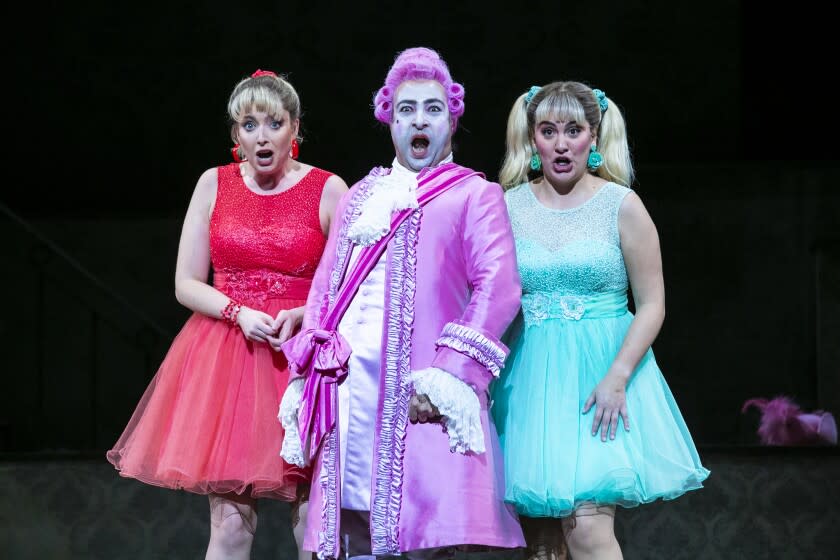Review: LA Opera stages an incongruous albeit successful 'La Cenerentola'

- Oops!Something went wrong.Please try again later.
“La Cenerentola” is the second-most often performed Rossini opera, with “The Barber Of Seville” being a runaway No. 1.
At the Los Angeles Opera, it’s made regular reappearances in 13-year intervals: first, during the company’s second season back in 1987, with Frederica Von Stade as the heroine and Neville Marriner in the pit. It returned with a comic, modern-dress garb rendition in 2000, as Jennifer Larmore made Cinderella’s treacherous coloratura flights sound easy. 2013’s production featured two contrasting Cinderellas taking turns in the role and included James Conlon setting a sparkling pace and a memorable collection of lovable, helpful rats.
On Saturday night, another version of the LA Opera’s “Cinderella” — originally scheduled for fall 2020 but moved back a year due to the pandemic — opened at the Dorothy Chandler Pavilion, coming a mere eight and a half years since the last one. This co-production of Dutch National Opera, Grand Théâtre de Genève and Valencia’s Palau de les Arts Reina Sofia tries to fuse two wildly different worlds together. It feels incongruous, but Rossini and Cinderella ultimately do come out on top.
“Cinderella” is a fairytale that has no set period and can be staged effectively in any era of history so long as class differences and dysfunctional families are present. For this version, director and costume designer Laurent Pelly places the home of down-and-out Don Magnifico (Cinderella’s bumbling, self-important stepfather) sometime in the 1950s or `60s, crammed with aging furniture, a Hotpoint refrigerator and other period appliances. These are shuffled about on several moving blocks; at times, the stage resembles an overstuffed storage unit. Cinderella’s stepsisters Clorinda and Tisbe are spoiled Valley Girls — all that's missing is one of them crying, “Gag me with a spoon!” — and a bespectacled Cinderella toils away cleaning the family’s home.
Meanwhile, the courtiers of the prince Don Ramiro are outfitted in 19th century wigs and costumes from Rossini’s time — except for the bespectacled incognito royal himself, which makes the initial mutual attraction between him and Cinderella more credible. These worlds clash openly when the court’s pink-and-white color scheme is superimposed onto the Magnifico home’s drab interior. That made counterintuitive sense in the Act I finale, a typical Rossini melee reflecting the characters’ confusion.
Then there is Alidoro, the prince’s tutor, who discovers Cinderella while disguised as a person experiencing homelessness. Even though Rossini doesn’t use a fairy godmother in his tale, Alidoro becomes one here when he transforms himself into a tuxedoed conductor who whisks a disbelieving Cinderella off to the ball, his baton acting as a magic wand that leads the action.
When Serena Malfi’s Cinderella sheds her glasses and appears at the ball, she bears an uncanny physical resemblance to a great Cinderella of our time, Cecilia Bartoli — a good omen. And the Neapolitan mezzo-soprano made good on the omen, conserving out her vocal resources so that all alone onstage, she was prepared for these impossible runs and scales of her final aria of wonderment and joy. She did so with flair and command.
Another vocal star who stood out was a familiar lead voice in LA Opera annals, bass-baritone Ildebrando D’Arcangelo, now serving as a debonair Alidoro in his conductor phase. As Don Ramiro, South African tenor Levy Sekgapane possessed the reedy lyric voice that one hears a lot in Rossini; the highest notes didn’t exactly ring, but they were there.
Alessandro Corbelli returned from the 2013 production for another go at Don Magnifico, his voice strengthening and becoming more agile in Act II’s opening patter aria. Rodion Pogossov was a preening dandy of a Dandini, and like Corbelli, had his best vocal moments in Act II.
Veteran conductor Roberto Abbado, a member of the Abbado musical dynasty, was in the orchestra pit for the first time on Saturday. Minus the tired practice of staged silliness during an overture, Abbado led this overture undistracted in front of a closed curtain, and his conducting grew stronger and sharper in rhythm during the second act. Alas, the many streams of rapid Rossinian patter were not even close to coherence in Act I, hurting the momentum of those wonderful, rushing crescendos that are so tough to sing.
Fortunately, LA Opera has a track record of pulling “Cinderellas” together after opening night. I attended the first and fourth performances of the opera in 2013 and was struck by how things tightened and acquired greater definition the fourth time around. In other words, this performance is likely to get even better by the day.
This story originally appeared in Los Angeles Times.

